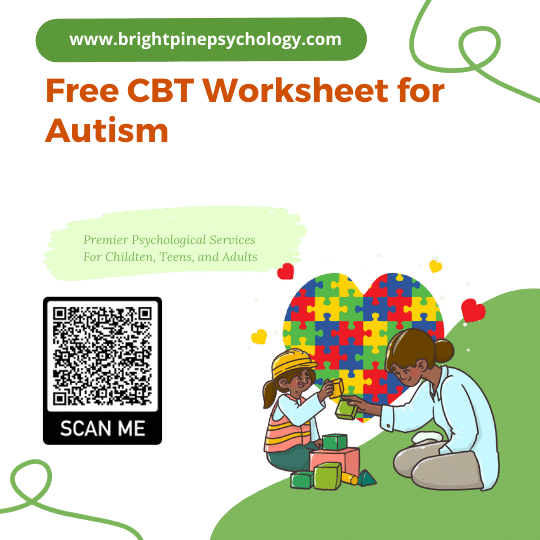Table of Contents
Free CBT Worksheet for Autism
Autism affects how individuals experience the world—including how they process emotions, respond to social situations, and handle change or sensory input. For many autistic children, teens, and adults, everyday experiences can feel overwhelming or difficult to interpret. That’s where structured tools like CBT worksheets for autism can be especially helpful.
Cognitive Behavioral Therapy (CBT), when adapted for autism, provides a practical, skills-based approach that supports emotional regulation, anxiety management, and problem-solving. A CBT worksheet for autism breaks down thoughts, feelings, and actions into clear, visual steps—making it easier to understand and respond to challenging situations.
These worksheets are not about “fixing” autism—they’re designed to support neurodivergent processing by offering predictability, emotional clarity, and actionable strategies for everyday life.
What Is a CBT Worksheet for Autism?
A CBT worksheet for autism is a structured form designed to help neurodivergent individuals:
- Identify what they are thinking, feeling, or experiencing
- Make sense of confusing or intense situations
- Build emotional vocabulary
- Explore the connection between thoughts, feelings, and behaviors
- Learn alternative coping strategies or ways to reframe challenges
These worksheets are often visual, step-by-step, and predictable—supporting the processing style of many autistic individuals. They may use checklists, color-coded sections, feelings charts, or social stories alongside standard CBT concepts.
Who Uses These Worksheets?
CBT worksheets for autism are used by:
- Children, adolescents, and adults on the autism spectrum
- Therapists and counselors specializing in neurodivergent care
- Parents and caregivers helping children with emotional regulation
- Special education professionals supporting students in school settings
- Autistic self-advocates working on their own coping strategies
These worksheets are most effective when adapted to the person’s communication style, developmental level, and sensory needs.
What Is the Purpose of the Worksheet?
The worksheet helps individuals:
- Make sense of overwhelming or confusing social and emotional experiences
- Increase awareness of their thoughts and triggers
- Replace rigid or negative thinking with more flexible and helpful thoughts
- Develop personalized coping strategies
- Feel a sense of structure and predictability in emotional learning
CBT worksheets for autism are not about “fixing” behavior—they’re about supporting understanding and building tools for self-regulation.
Effectiveness of CBT for Autism
CBT is well-established as an effective therapy for:
- Anxiety, which is common in autism
- Emotional dysregulation
- Social thinking challenges
- Rigid or repetitive thought patterns
Research shows that when CBT is adapted for neurodivergent individuals, it can lead to meaningful improvements in emotional regulation, self-esteem, and daily functioning.
Key adaptations include:
- Using visual supports
- Allowing extra processing time
- Emphasizing concrete examples
- Involving family or support systems as needed
Common Questions About CBT for Autism
Can CBT really work for people with autism?
Yes—but adaptation is essential. Traditional CBT may not always resonate with autistic individuals unless it’s personalized with visuals, concrete language, and support for emotional identification. When tailored appropriately, CBT can be very effective.
Is CBT trying to make autistic people act neurotypical?
Good question. Ethical CBT for autism is not about masking or forcing conformity. Instead, it’s about helping the individual cope with anxiety, understand their emotions, and function in a world that may not be designed for their needs.
At what age can someone start using CBT worksheets?
Even young children (around age 6–7) can benefit from simplified CBT worksheets, especially when paired with visuals or guided support. Teens and adults can use more advanced versions with more reflection or problem-solving.
How is CBT for autism different from CBT for anxiety or depression?
The core CBT principles are similar, but for autism, therapy often emphasizes:
- Literal, concrete examples
- Visual structure
- Support for emotional awareness and social reasoning
- Patience with processing time and sensory needs
Can CBT help with meltdowns or shutdowns?
Yes. CBT worksheets can help individuals identify early signs, understand what led to the distress, and develop coping plans or exit strategies for future situations. Over time, this promotes greater self-regulation.
Can parents or teachers use CBT worksheets with kids?
Absolutely. In fact, collaborative use of worksheets can build emotional vocabulary and trust. Teachers, therapists, and caregivers can help guide the process while honoring the child’s unique perspective.
What if the person struggles with verbal communication?
CBT can be adapted for non-verbal or limited-verbal individuals using:
- Visual aids
- Emotion symbols
- Choice boards
- Simple, multiple-choice prompts rather than open-ended questions
Communication support professionals can work alongside CBT therapists to personalize these tools.
Want to Try a CBT Worksheet for Autism?
Download a Free CBT Worksheet for Autistic Youth or Adults.
Use it to help process emotions, manage change, and feel more in control of confusing situations.
Final Thoughts
Autistic individuals deserve therapy that is respectful, personalized, and effective. CBT worksheets—when properly adapted—can be a valuable tool for building self-understanding, emotional regulation, and coping skills in everyday life. At Bright Pine Behavioral Health, we recognize how important clarity and support are when navigating the possibility of an autism diagnosis. Our licensed and experienced clinicians specialize in comprehensive autism assessments for individuals of all ages. Whether you’re seeking a traditional evaluation, need expedited testing for faster results, or are unsure where to begin, we’re here to guide you every step of the way.
We encourage you to start by submitting your information through our secure form or scheduling a consultation call. During this call, one of our experienced clinicians will listen to your concerns, explain the assessment process, and help determine the best path tailored to your needs. We also offer free autism screening tools on our website to help you decide whether a full evaluation may be appropriate.
Whether you’re a parent, therapist, teacher, or autistic adult seeking support, CBT worksheets combined with professional guidance from Bright Pine Behavioral Health can provide a compassionate, clear, and empowering way to navigate life’s challenges with confidence and understanding.



